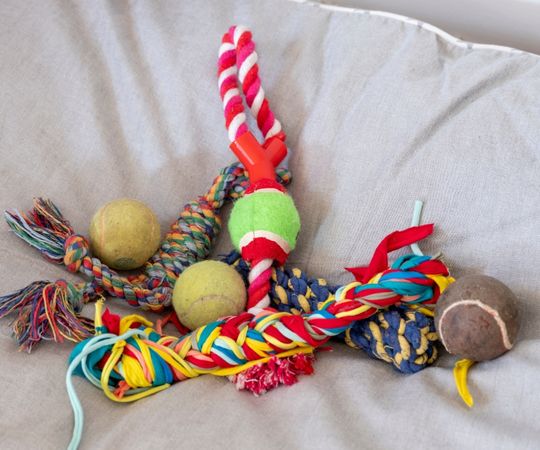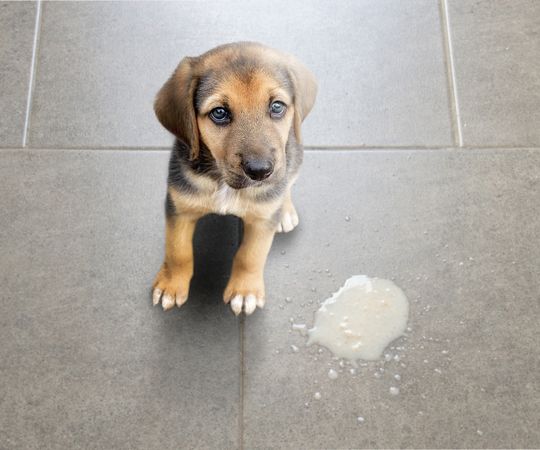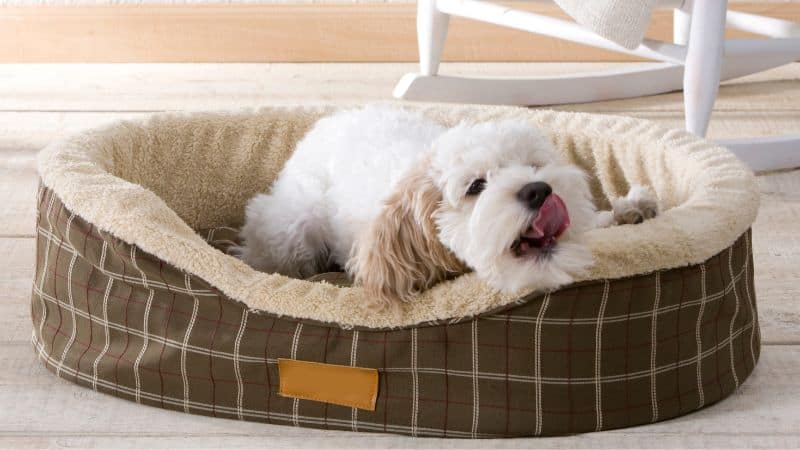
Is Your Dog Destroying Their Bed? Chewing their bed isn’t just messy and costly—it can be dangerous. Your dog might ingest harmful stuffing or damage their teeth.
This guide will help you identify why your dog chews their bed, how to recognize destructive chewing, and the most effective ways to stop it. With the right approach, you can protect your dog, save money on replacements, and finally enjoy a chew-free home.
Common Causes of Bed Chewing
Dogs often chew their beds for specific, identifiable reasons. Understanding the root cause can help you choose the right solution and prevent damage.
Teething (Puppies)
Puppies go through a teething stage between 3 and 6 months old. During this time, their gums can feel sore as adult teeth replace baby teeth. Chewing helps relieve discomfort and loosen stubborn baby teeth.
If your puppy loves chewing their bed, it may be because the fabric offers a satisfying texture. Soft materials can feel good on sensitive gums, but they can also be easily destroyed.
Boredom
Dogs need mental and physical stimulation. If they do not get enough, they may chew to pass the time. This often happens when a dog spends long hours alone without toys or activities.
Chewing can become a way to release built-up energy. Beds are often within reach, making them an easy target.
Anxiety or Stress
Chewing can be a coping behavior for dogs experiencing anxiety. Common triggers include loud noises, changes in routine, or separation from you.
Some dogs chew to self-soothe when they feel nervous. The repetitive action can help them feel calmer.
Hunger
If your dog’s diet does not meet their nutritional needs, they may chew out of hunger. This can also happen if they have to wait too long between meals.
Some dogs may chew on their bed because they smell food residues or crumbs on it. Others may chew to satisfy the urge to eat something.
Inadequate Training
Dogs often chew beds because they have not learned what is acceptable to chew. Without guidance, they may not understand the difference between toys and household items.
If your dog has access to their bed unsupervised and chews it without correction, the habit can become stronger over time.
Signs of Destructive Chewing
You can often spot destructive chewing by looking for damage to items that are not meant for chewing. This includes torn bedding, shredded fabric, or stuffing scattered around your dog’s sleeping area.
Dogs may also leave teeth marks, holes, or frayed edges on their bed. These signs usually appear repeatedly in the same spots over time.
You might notice your dog chewing when bored, anxious, or left alone for long periods. In some cases, chewing starts soon after you leave the room.
Behavioral signs can include:
| Sign | What It Might Mean |
|---|---|
| Chewing when alone | Separation anxiety or boredom |
| Licking or gnawing one spot | Comfort-seeking or habit |
| Restless pacing before chewing | Stress or excess energy |
Pay attention to patterns. If chewing happens at certain times or after specific events, it can help you understand the cause and choose the right solution.
Effective Ways to Stop Dogs from Chewing Their Bed
You can reduce destructive chewing by giving your dog appropriate toys, reducing stress, meeting their physical and mental needs, training, and removing temptations.
Providing Dog Chewing Toys
You can provide some chew toys for dogs to replace their chewing on beds. Note that these toys must be made of safe and durable materials. For puppies, they should not only be sturdy but also gentle on their gums to avoid harm. It’s best to choose specially designed frozen toys that can soothe teething puppies’ gum pain. Here are some specific alternatives:
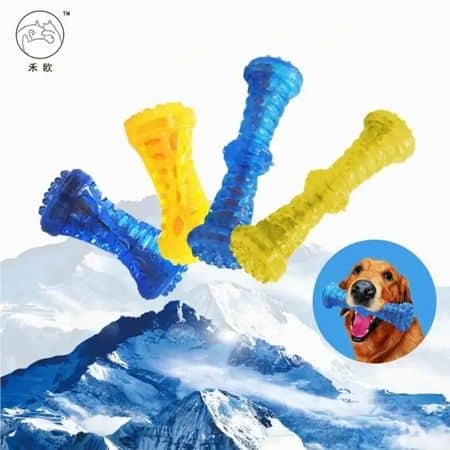
Crafted from TPR, a non-toxic and bite-resistant material, this Frozen Dumbbell Chew Toys for Puppies is gentle on your puppy’s gums and teeth while being strong enough to withstand vigorous chewing. The toy contains ice beads and can be placed directly in the refrigerator to freeze. Once frozen, it provides a soothing and refreshing experience for your puppy, especially during teething stages. The surface features bumpy, soft spikes that help your dog grind their teeth and clean them naturally.
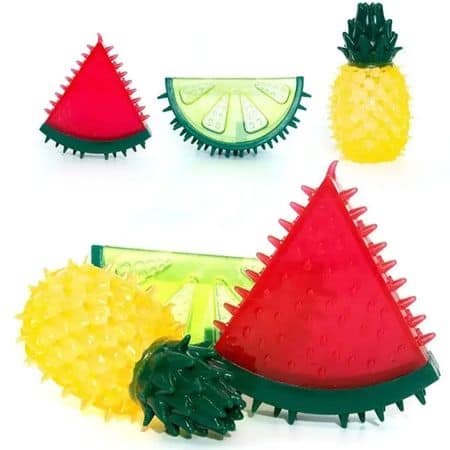
TPR Frozen Fruit Dog Toy for Teething is a delightful and functional addition to any pet’s toy box. It is also crafted from tough, non-toxic TPR that’s safe for repeated chewing and designed to be cool and refreshing, aiding in teething and promoting dental health. What’s more, this fruit dog toy is available in various fruit shapes like watermelon, pineapple, lemon, and popsicle to suit different preferences. Contact us and order now!
Reducing Stress
Reducing stress can make it easier to redirect chewing toward appropriate items. To address anxiety-related chewing, identify and reduce stress triggers when possible. Provide a calm environment where your dog feels safe. This may include using a crate with a comfortable mat, keeping a predictable schedule, and avoiding long stretches of isolation.
You can also use enrichment activities or calming aids, such as snuffle mats, veterinarian-recommended anxiety wraps, pheromone diffusers, or soft background music.
Your reassurance is indispensable. Before leaving your dog, be sure to comfort and soothe them to prevent severe separation anxiety.
Increasing Daily Exercise
Most adult dogs benefit from at least 30–60 minutes of physical activity each day, depending on their breed and health. This can include brisk walks, fetch, or supervised off-leash play. Exercise helps burn off excess energy and reduces boredom. Tired dogs are less likely to chew destructively.
Break the exercise into multiple sessions if possible. A morning walk plus evening play can help prevent restlessness during the day or night.
If your dog is alone for extended periods, consider hiring a dog walker or using dog daycare a few times a week.
Adding Mental Stimulation
Mental stimulation is just as important as physical exercise. Dogs that lack mental challenges often look for their own entertainment, which can include chewing the bed.
Interactive dog toys keep your dog busy and redirect chewing away from beds. Choose toys made from durable, non-toxic materials that can handle your dog’s chewing strength.
- Use food puzzle toys, snuffle mats, or hide-and-seek games with treats. Training new commands or tricks can also keep your dog’s mind active.
- You can make mealtime more engaging by feeding from a slow feeder or treat-dispensing balls instead of a regular bowl.
- If your dog prefers softer textures, provide plush toys designed for heavy chewers.
Always supervise new toys at first to ensure they don’t break into unsafe pieces.
Switching to Chew-Proof Dog Beds
If your dog keeps chewing their bed, a chew-proof dog bed can prevent damage and reduce the risk of swallowing fabric or stuffing.
Look for beds made from reinforced fabric like ballistic nylon or heavy-duty canvas. Many chew-proof beds have metal frames or elevated designs that make it harder for dogs to grab and tear the material. Avoid beds with zippers, loose seams, or exposed stuffing. These can tempt chewing and create choking hazards.
You can also use deterrent spray on the bed to make it less appealing, while encouraging chewing on the toys instead.
Training Effectively
Teaching your dog to chew toys instead of beds is crucial. Training should include clear rules and consistent redirection. When you see your dog chewing the bed, replace it with an appropriate chew toy and praise them for using it.
If chewing continues despite your efforts, a professional dog trainer or veterinary behaviorist can help. They can identify underlying causes such as anxiety, lack of training, or medical issues. They can also recommend specific training tools or management strategies to help redirect your dog’s chewing behavior and consistently reinforce good habits.
Frequently Asked Questions
Which sprays work best to deter dogs from chewing on their beds?
Bitter-tasting sprays, such as bitter apple or citrus-based deterrents, can make the bed less appealing to chew. Always test a small area first to ensure the spray does not damage the fabric. You may need to reapply regularly, especially after washing the bed.
What causes a dog to chew on their bed during the night?
Nighttime chewing can happen if your dog feels anxious, bored, or uncomfortable. Lack of evening exercise, separation anxiety, or discomfort from the bed itself can trigger the behavior.
What strategies can I use to stop my dog from destroying his bed in his crate?
Provide safe chew toys inside the crate to redirect chewing. Use a bed made for crate use, with tough covers and minimal seams. If chewing continues, you may need to remove the bed temporarily and replace it with a crate mat or blanket until the habit improves.
Are there any durable materials like Kevlar used in dog beds to prevent chewing?
Some manufacturers use Kevlar or ballistic-grade fabrics in heavy-duty dog beds. These materials are more resistant to tearing and punctures than standard fabrics.


